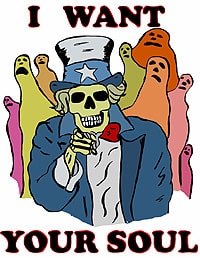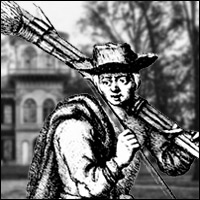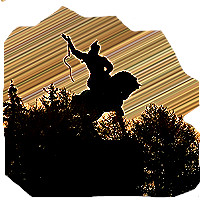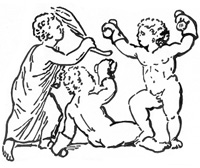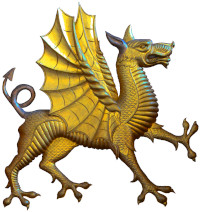It is well established that Eastern Woodland tribes adopted European Americans who befriended them, who were captured by them in raids and who were sold to them by English, French and Indian slave traders. This happened to a far greater extent in the east than in the far west, which brings up the idea of ethnic empathy.
It is prolifically documented in period art and in early photography that Amerindians of the Eastern Woodlands, were both physically more robust than the European immigrants yet shared a similar facial structure and complexion with lower class Europeans to a greater degree than with the gracile and paunchy aristocracy. Also, these folk appear racially and culturally distant to the tribes west of the Mississippi and are again, more physically robust.
There is also the demographic mystery that while 95% of Indians in Middle and South America died within a generation of European contact via pandemic outbreaks of diseases they had no immunity to, that in 1675, after 7 generations [reckoned at 25 years] that the Native American population in the Eastern Woodlands had only been reduced by 40%. Lack of population density has been given credit for this, however, many tribes lived in large towns of up to 3,000 on major waterways accessed by European shipping at least as far back as de Varanzanno in 1524.
Furthermore, Soto’s Entrada of 1541-44 did depopulate large regions of the South of what would become English-speaking North America. The obvious difference is that Soto and his men died or sailed off, where the English placed vulnerable settlements from which adopted members were extracted according to the above methods, with Maryland Governor, Lord Calvert even selling Englishmen to Iroquois tribesmen in return for furs in 1675.
However, this is a mark of an existing empathy, not the beginning. The beginning of intermarriage and adoption on a large scale in what became the Eastern United States began in the late 1400s with Basque, Dutch, English and Italian fishermen, explorers and merchants interacting in a predominantly peaceful fashion with the natives. A survey of the primary sources informs the reader early on, that from 1492 through the early 1800s voyages of exploration undertaken by captains from Portugal, Spain, England and Holland, were staffed largely by condemned men, “the sweepings of the prisons and jails” and impressed men who had been brutally kidnapped and slaved in what was perhaps the worst working conditions of any human being beyond the Roman silver mines of antiquity, being an able seaman in the Age of Sail. Further, the sources from Magellan onward are replete with mutinies, castaways and shipwrecks, but most of all, of runaway seamen, who, if they stayed in the coastal native communities, were typically surrendered back by their master’s trading partners.
So, if one were to runaway, one needed to head for the hills, to the largely Iroquoian tribes, who, as the coastal tribes wore thin from disease, waxed strong in their mountains. From the 1630s, alliances had been struck up with mountain tribes by coastal planters often resulting in the slaughter of these coastal peoples caught “between two fires.”
Other hints that the more warlike tribes of the interior, who at first allied with the English and then fought the most fiercely, including the Algonquin Shawnee, were racially made up of a large degree by runaway English sailors and slaves and castaways [like the 97 English sailors stranded by Drake and Hawkins in 1566] before the post settlement period of slave trading- and abduction-based adoption, are:
-Numerous first contact chiefs, including Henry, Powhatan and Mosco were bearded.
-Interior tribes got on better with planters and pioneers than coastal tribes and fought more fiercely against later colonial and American government intrusion.
-English and Norse style housing were in use at first contact from Virginia to New York.
-Arlington Mallory investigated numerous pre-17th century iron forges in Virginia, Pennsylvania and Ohio, further north than Soto’s expedition ever reached.
-There was an intense hatred of French Catholic Missionaries on the part of numerous Iroquois warriors, who actually martyred some Jesuits with brutal irony, such as crucifying them and baptizing them with boiling water.
Increased Ethnic Empathy
Trends that indicate an intensification of intermarriage and ethnic empathy between interior tribes and the English in the Plantation Era were:
-The increase in size of these populations post contact, with the Susquehannocks’ doubling their numbers every generation for over a hundred years from 1525 through 1661.
-The abandonment of the archery equipment with superior range, accuracy, portability, field-repair, rate-of-fire, wet weather performance, impact [see the Jamestown parley where the bow was proved more powerful than the heavy musket], with the only advantage being reduced deflection in wooded settings. This worship of iron—a literal holy metal, in Indian possession before first contact—actually tied the interior tribes to the coastal planters, who trafficked in people, furs, war and weapons to the detriment of coastal tribes and bound them together to a degree that use of firearms in combat was actually taught to British soldiers and American frontiersmen by Indian warriors. Wellington’s riflemen in the Iberian campaign of 1809 were fighting “Indian style.”
-Over half of all period art depicting tribal chiefs among these interior warrior nations, comprising all the Iroquoian folk and the Shawnee, Delaware and others, are distinctly Caucasian in appearance and are often in possession of Christian names. Only in 20th and 21st century depictions do Eastern Woodland Indians begin to look like Trans-Mississippi Indians.
-The following tribes did not have indigenous names, but rather English names:
Delaware
Susquehannock
Conestoga
Doegs
Westos [slavers]
Stockbridge
Brotherton
Neutral
Lumberton
The painting of William Penn’s 1683 treaty with the Delaware stands out as a stark example of the interracial nature and strong Caucasian racial strain of Eastern Woodland tribes in the English sphere of influence, from pre-settlement times. Indeed, the iconic tomahawk was invented by Penn as a trade good, based on a variety of stone and iron war axes already in use.
And finally, the Scottish, Cornish, Welsh and Irish habit of running to the hills when the English nation came a conquering was so deeply imbedded in the minds of such men trafficked into bondage in America, that an American sub-race, the hillbilly was eventually born from it, making it no great leap of the imagination to contend that these crackers, hillbillies, rednecks, gaolbreakers and runagates of the late 1700s where not the first of their kind to run to the hills—and they were not the last, for this white-boy is headed to the hills next week and leaving the graveyard of my slave ancestors behind.
Fascinatingly enough, the white guilt song below reflects much more accurately the reality experienced by Tribesmen who looked a lot like these musicians, because they were largely of their race. And even on the plains they sing about there were at least a handful of blue-eyed Indians fighting the system until it inevitably won and bound us all in its grasp.
Support Plantation America Research
To support this project and view some graphics go to:
link › patreon.com/jameslafond




